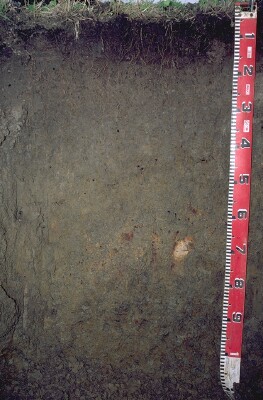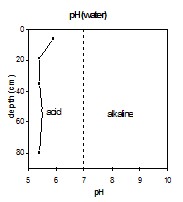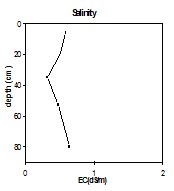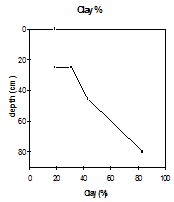SW6b
Location: Garvoc
Australian Soil Classification: Vertic (and Acidic), Eutrophic, Brown DERMOSOL
General Landscape Description: Gently undulating volcanic plain.
Geology: Quaternary basalt (Rvn).
 Sw6b Landscape |
Soil Profile Morphology:
Surface Soil
| A11 | 0-12 cm | Very dark brown (10YR2/2) very fine sandy clay loam; moderate medium blocky, parting to moderate fine blocky structure; weak consistence moderately moist; pH 5.9; clear change to: |  SW6b Profile |
| A21 | 12-25 cm | Dark greyish brown (10YR4/2) (10YR6/2d) very fine sandy clay loam; weak coarse blocky structure; rusty root channel mottling present; weak consistence moist; pH 5.4; clear change to: | |
| Subsoil | |||
| B21 | 25-45 cm | Dark greyish brown (10YR4/2) with slight yellowish brown (10YR5/6) mottled medium clay; moderate coarse blocky, parting to moderate medium blocky structure; firm consistence moist; pH 5.4; gradual change to: | |
| B22 | 45-60 cm | Brown (10YR5/3) with yellowish brown (10YR5/6) mottled medium clay; moderate medium blocky structure; firm consistence moist; contains a slight (10%) amount of ferruginous nodules (4 -10 mm size); pH 5.5; clear change to: | |
| B23 | 60-80 cm | Greyish brown (10YR5/2) heavy clay; contains a moderate (40%) amount of ferruginous (4 -10 mm size) nodules (and a vesicular bomb (90 cm diam.)); clear change to: | |
| B3 | 80 cm+ | Greyish brown (10YR5/2) with brownish yellow (10YR6/8) mottled heavy clay; strong coarse lenticular, parting to strong fine lenticular structure (shiny faced peds); firm consistence moist; pH 5.4. |
Key Profile Features:
- Lack of strong texture contrast between surface (A) and subsoil (B) horizon.
- Vertic properties in deeper subsoil (ie. lenticular peds).
Soil Profile Characteristics:
Soil Profile Characteristics:
- | pH | Salinity | ||
Surface Soil (A11 horizon) | Moderately Acid | Very High | Sodic | None |
Subsoil (25-45 cm) | Strongly Acid | Medium | Sodic | None1 |
Deeper Subsoil (80+ cm) | Strongly Acid | Medium | Sodic | None |
 | The surface soil is moderately acid. The subsoil is strongly acid throughout. |  | The salinity rating is medium-high for the surface horizons; medium for the upper subsoil, and medium-high in the deep subsoil. |
| There is only a moderate texture contrast at the A/B horizon interface. The clay % gradually increases with depth down the soil profile. |
Chemical and Physical Analysis:
Horizon | Horizon Depth (cm) | pH (water) | pH (CaCl2) | EC dS/m | NaCl % | Exchangeable Aluminium ppm | Exchangeable Cations | Coarse Sand (0.2-2.0 mm) % | Fine Sand (0.02-0.2 mm) % | Silt (0.002-0.02 mm) % | Clay (<0.002 mm) % | Wilting Point % w/w | |||
Ca | Mg | K | Na | ||||||||||||
meq/100g | |||||||||||||||
A11 | 0-12 | 5.9 | 5.4 | 0.59 | 0.11 | 7 | 4.2 | 0.95 | 1.9 | 5 | 38 | 24 | 19 | 21 | |
A21 | 12-25 | 5.4 | 4.8 | 0.52 | 0.11 | 26 | 2.4 | 2.1 | 0.39 | 1.3 | 5 | 43 | 32 | 19 | 10 |
B21 | 25-45 | 5.4 | 4.6 | 0.33 | 007 | 32 | 2.3 | 3.4 | 0.42 | 1.3 | 7 | 37 | 26 | 31 | 13 |
B22 | 45-60 | 5.5 | 5.0 | 0.48 | 0.11 | <10 | 2.4 | 5.1 | 0.46 | 1.8 | 10 | 27 | 20 | 43 | 17 |
B3 | 80+ | 5.4 | 5.1 | 0.70 | 0.19 | <10 | 3.5 | 11 | 0.26 | 2.6 | 2 | 8 | 8 | 84 | 34 |
Management Considerations:
Whole Profile
- Plant available water capacity is considered to be low (estimated at 93 mm) for the top metre of this soil profile. This is based on available laboratory data.
- The surface soil has a very high organic matter content.
- The subsoil is strongly acid throughout. This indicates that toxic levels of aluminium and manganese may be present. Levels of exchangeable aluminium measured in the laboratory for this site are, however, not high.
- The upper subsoil has a low inherent fertility (based on the sum of the basic exchangeable cations).
- The level of soluble salts in the upper subsoil may restrict the growth of highly salt sensitive species.
- The deeper subsoil displays vertic properties (ie. lenticular peds). This indicates that significant shrinking and drying occurs during wetting and drying cycles. This will cause subsoil movement and probably resulted in some degree of gilgai (ie. 'crabholey') microrelief developing. Variations in subsurface horizons has occurred which has resulted in variations in soil profiles over a small area (eg. Profiles 6a and 6B occur within the same soil pit). Soils with strongly developed vertic properties have implications for engineering purposes (eg. building foundations).



